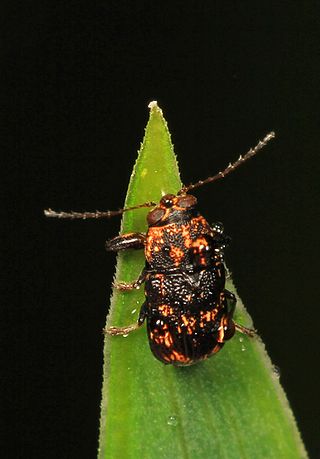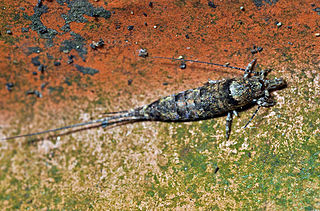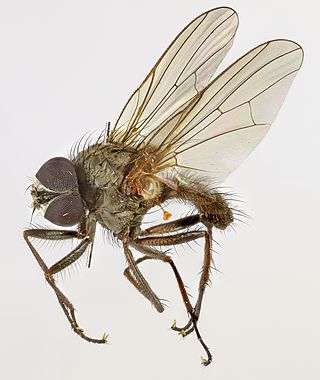
The Anthomyiidae are a large and diverse family of Muscoidea flies. Most look rather like small houseflies. Most species are drab grey to black. Many Pegomya are yellow, and some members of the genera Anthomyia and Eutrichota are patterned in black-and-white or black-and-silvery-grey. Most are difficult to identify, apart from a few groups such as the kelp flies that are conspicuous on beaches.

Pallopteridae is a family of flies. The various species are collectively called flutter-wing flies, trembling-wing, or waving-wing flies, because of the striking vibration of the wings in many species. Over 70 species in about 15 genera are found in the temperate regions of the Northern and Southern Hemispheres.

Pachybrachis is a genus of scriptured leaf beetles in the family Chrysomelidae. There are at least 220 described species in Pachybrachis.

Pegomya is a genus of flies within the family Anthomyiidae. Some species are considered pests due to their leafmining larvae. Species include:

Campiglossa is a genus of fruit flies in the family Tephritidae. There are at least 190 described species in Campiglossa.
Phyllocnistis wygodzinskyi is a moth of the family Gracillariidae, known from Argentina. It was described by German entomologist Erich Martin Hering in 1958. The larvae feed on Asteraceae species. They probably mine the leaves of their host plant.

iNaturalist is an American 501(c)(3) nonprofit social network of naturalists, citizen scientists, and biologists built on the concept of mapping and sharing observations of biodiversity across the globe. iNaturalist may be accessed via its website or from its mobile applications. iNaturalist includes an automated species identification tool, and users further assist each other in identifying organisms from photographs and even sound recordings. As of 9 July 2024, iNaturalist users had contributed approximately 197,660,888 observations of plants, animals, fungi, and other organisms worldwide, and 290,007 users were active in the previous 30 days.

Trigoniophthalmus is a genus of jumping bristletails in the family Machilidae. There are about 11 described species in Trigoniophthalmus.
Eosentomon wygodzinskyi is a species of proturan in the family Eosentomidae. It is found in Africa, Australia, South America, and Southern Asia.

Atrachelus cinereus is a species of assassin bug in the family Reduviidae. It is found in Central America, North America, and South America.

Hyaliodes is a genus of plant bugs in the family Miridae. There are at least 20 described species in Hyaliodes.
Pegomya carduorum is a species of root-maggot flies.
Pegomya rufescens is a species of root-maggot flies.
Pegomya depressiventris is a species of root-maggot fly.

Pegomya flavifrons is a species of root-maggot fly.
Pegomya pseudobicolor is a species of root-maggot fly.
Clinohelea is a genus of biting midges in the family Ceratopogonidae. There are at least 40 described species in Clinohelea.
Paurocoris is a genus of dirt-colored seed bugs in the family Rhyparochromidae. There are at least two described species in Paurocoris.

Acrosternum is a genus of stink bugs in the family Pentatomidae. There are more than 20 described species in Acrosternum.

Biosteres is a genus of wasps belonging to the family Braconidae.











